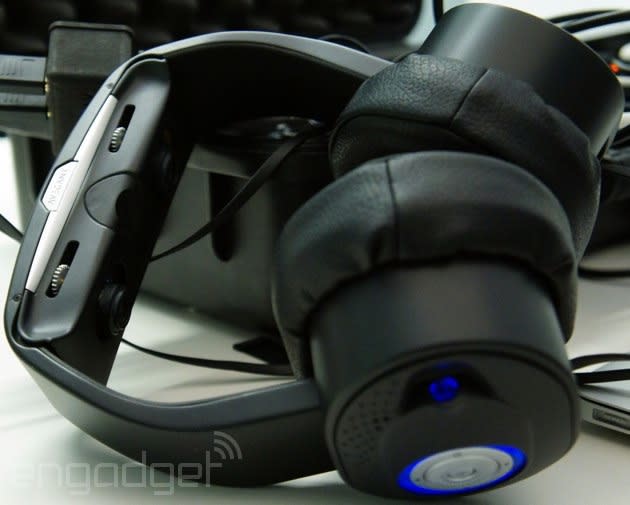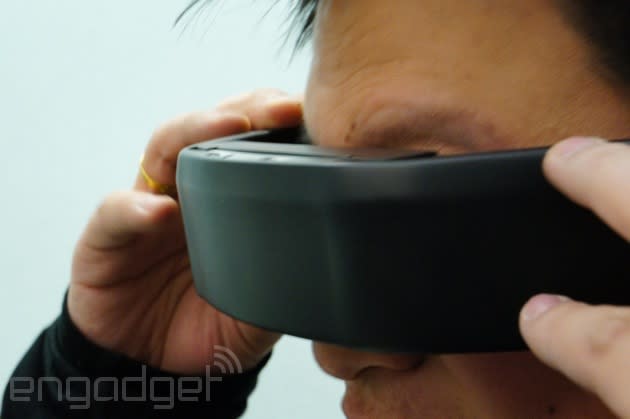Avegant Glyph home theater headset isn't competing with Oculus Rift (hands-on)

We've spent gobs of time with variations of Oculus VR's Rift headset -- the original duct-tape prototype, the first dev kit and even an updated HD version. We've spoken to creator Palmer Luckey several times, and company reps have graced Engadget stages at both CES 2013 and last March's first-ever Expand event in San Francisco.
Avegant's Glyph, however? We've only just begun. The home theater headset just got a name, and the first prototype looked an awful lot like what you'd see underneath a Terminator cyborg's smooth visage. As Oculus did before, the scrappy eight-person team at Avegant is taking its impressive proof-of-concept to Kickstarter in hopes of funding a beta unit: $500 is the base level for a Glyph, and the project is set to go live on January 22nd. And this sentence -- right here! -- is where we're gonna stop speaking about the Glyph as if it's competing with the Oculus Rift. As Avegant's CEO Ed Tang told us late last week: "We're not trying to compete with Oculus."
There's good reason for that. For starters, the Glyph is really, really different from the Rift. Like, dramatically different. Yes, they're both video headsets. Yes, they both offer some form of interactivity. What each is trying to achieve, however, is starkly different. The Rift aims for deep immersion -- it cuts off your field of view, encompassing your entire spectrum of vision -- whereas the Glyph operates more like a set of sunglasses. You can play games on it, but it's really more suited for movie watching (say, on a plane). Both the alpha model we tried late last week ("hot off the production line!") and the beta model that'll ship to Kickstarter backers have a relatively small 45-degree field of view, allowing for a partially obstructed perspective of the world while using the Glyph. It's this conceit that makes all the difference between the two.
As such, if you're looking for the immersive virtual reality experience that the Rift offers, stop looking at the Glyph. If you're looking for a $500 way to buy your own, very personal home/mobile theater (that's still in beta), the Glyph is spot-on. As previously reported, the Glyph's image is extremely crisp. Similarly impressive, it can do 3D without any glasses: it projects the image directly onto your retinas rather than using a screen. The effect, however, is more than a little underwhelming. Sure, the image is nice, but it's surrounded by a massive dead space that feels wasted. Moreover, we spent three to four minutes adjusting the interpupillary distance (IPD) -- the space between your eyes -- just to make it work. That's three to four minutes longer than it should take to make a $500 visual entertainment device function.

Another major differentiator from the Rift? Glyph has a fancy pair of headphones built in. If you want to be all the way crazy, you can wear the device like a standard set of (very large) headphones. Normally, though, it just serves as a means to make video viewing more comfortable. It's a smart addition, but adds yet another layer of adjustment: Not only are you adjusting the IPD, but also how tight the whole apparatus is on your head. The alpha model we tried had a headstrap, though it isn't planned for the beta. We're also told that the beta model will be considerably lighter -- as it stands, the Glyph rests somewhat uncomfortably on noses.
So, who is the Glyph for? Not just gamers, that's for sure. A single MHL/HDMI wire will attach the Glyph to virtually anything -- we even tried some mobile gaming with a Lightning adapter on an iPhone 5. An expected three-hour battery life, however, applies some serious limitations to viewing on the go. As best we can tell, like Google Glass' Explorer Edition and Oculus' Rift dev kit, the Glyph beta unit is meant for early adopters who are willing to put up with a very promising wearable that isn't ready for retail just yet. Oh, and developers. But not for your parents (or even you, probably) just yet.






















